The AMD Radeon R9 290 Review
by Ryan Smith on November 5, 2013 12:01 AM EST- Posted in
- GPUs
- AMD
- Radeon
- Hawaii
- Radeon 200
Overclocking
Finally, let’s spend a bit of time looking at the overclocking prospects for the 290. Without any voltage adjustment capabilities and with AMD binning chips for clockspeeds and power consumption we’re not necessarily expecting a lot of headroom here, but none the less it’s worth checking out to see how much more we can squeeze out of the card.
Even though we’re officially limited to AMD’s Overdrive utility for the moment for overclocking, Overdrive offers a wide enough range of values that we shouldn’t have any problem maxing out the card. In fact we’ll be limited by the card first.
| Radeon R9 290 Overclocking | |||
| Reference Radeon R9 290 | |||
| Shipping Core Clock | 662MHz | ||
| Shipping Boost Clock | 947MHz | ||
| Shipping Memory Clock | 5GHz | ||
| Shipping Boost Voltage | ~1.18v | ||
| Overclock Core Clock | 790MHz | ||
| Overclock Boost Clock | 1075MHz | ||
| Overclock Memory Clock | 5.6GHz | ||
| Overclock Max Boost Voltage | ~1.18v | ||
Despite the lack of voltage control, when it comes to overclocking the 290 we were able to achieve solid overclocks on both the GPU and the memory. On a boost clock basis we were able to push the 290 from 947MHz to 1075MHz, an increase of 128MHz (14%). Meanwhile we were able to push the memory from 5GHz to 5.6GHz before artifacting set in, representing a 600MHz (12%) memory overclock. Being able to increase both clockspeeds to such a similar degree means that no matter what the video bottleneck is – be it GPU or memory – we should see some kind of performance increase out of overclocking.
On a side note, for overclocking the 290 we stuck with moderate increases to both the maximum fan speed and the PowerTune limit. In the case of the former we used a 65% maximum fan speed (which actually proved to be more than what’s necessary), while for the latter we went with a 20% increase in the PowerTune limit, as at this point in time we don’t have a good idea for what the safe power limits are for the reference 290/290X board. Though in either case only FurMark could push the overclocked card to its power limit, and nothing could push the card to its fan speed limit. Similarly we didn’t encounter any throttling issues with our overclocked settings, with every game (including CoH2) running at 1075MHz sustained.
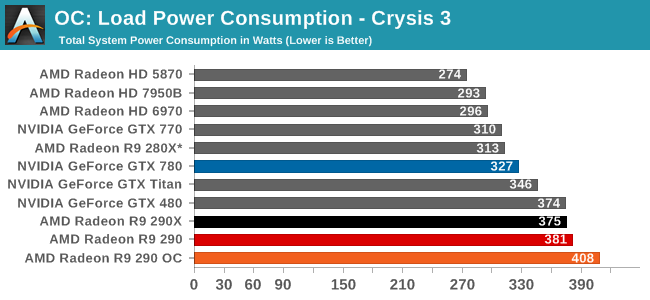
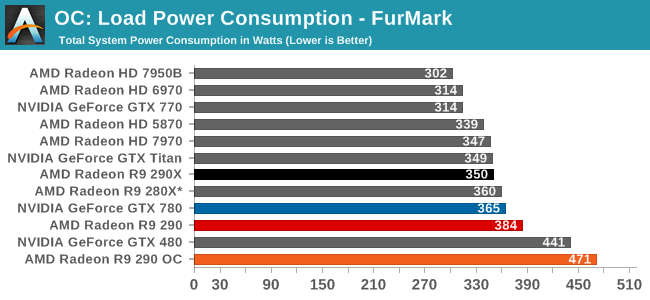
Taking a brief look at power, temp, and noise before jumping into our gaming performance results, we can see that overclocking the card has a measurable impact on power consumption under both Crysis 3 and FurMark. With Crysis 3 we’re clockspeed limited before we’re power limited, leading to an increase in power consumption of 27W, while under FurMark where we were power limited it’s a much more academic increase of 87W.
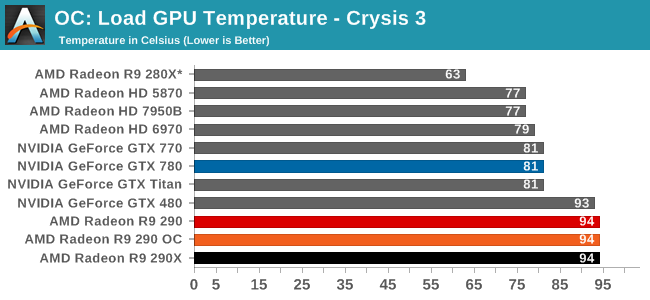
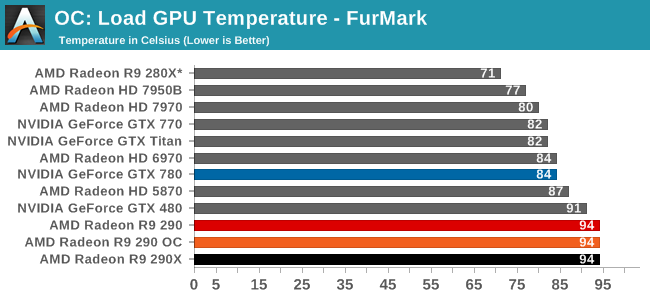
Since the 290 already ships at the highest temperate limit it allows – 95C – our sustained temperatures are unchanged even after overclocking.
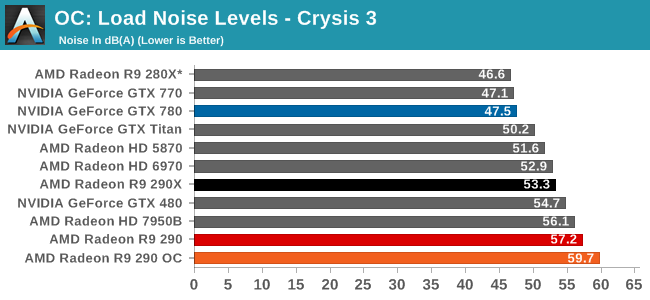
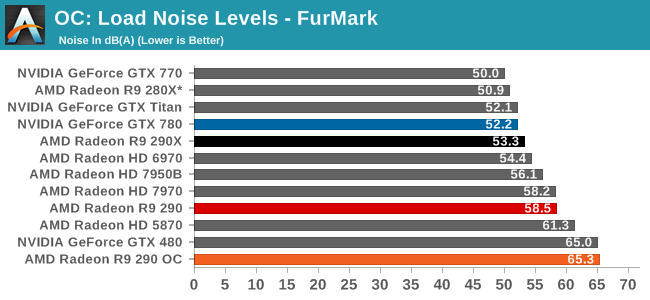
The 290 is already an unreasonably loud card at stock, and unfortunately the fan speed increases needed to handle the greater heat load from overclocking only make this worse. Under Crysis 3 we peaked at 59.7dB, or 49% fan speed. While under FurMark we peaked at 65.3dB, or 59% fan speed. For these noise levels to be bearable the 290 really needs to be fully isolated (e.g. in another room) or put under water, as otherwise 59.7dB sustained is immensely loud for a video card.
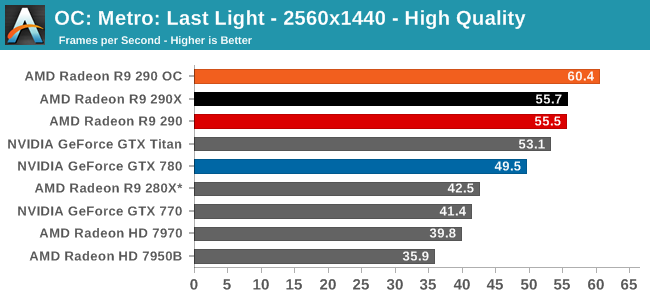
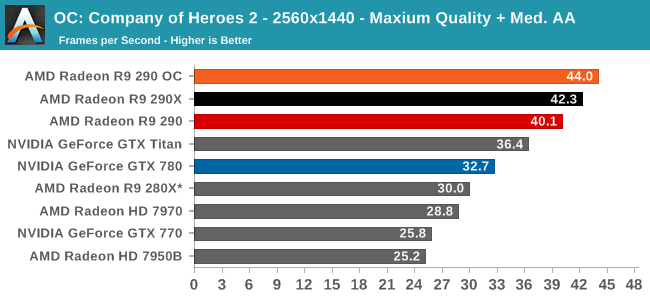
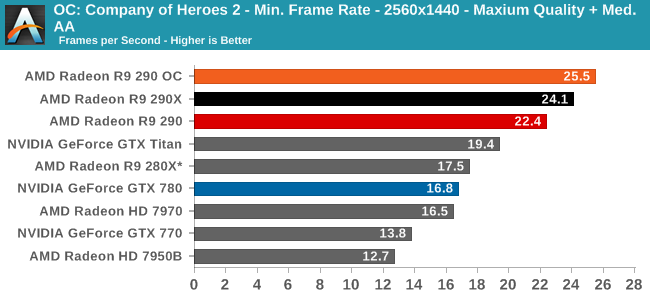
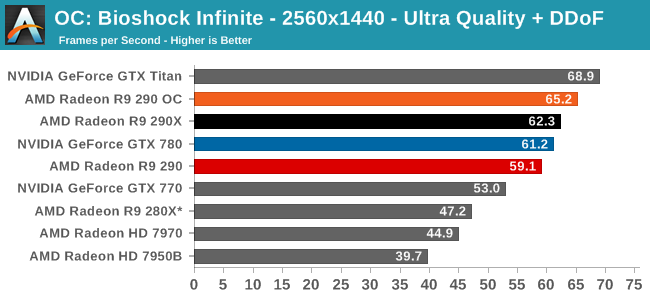
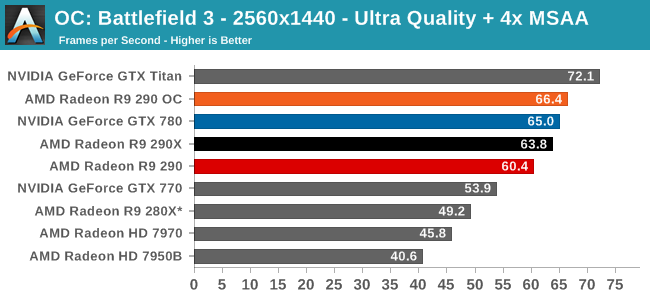
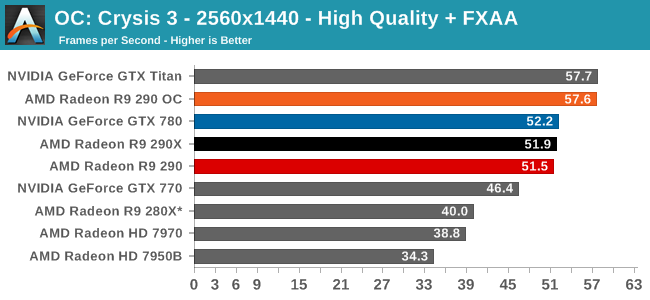
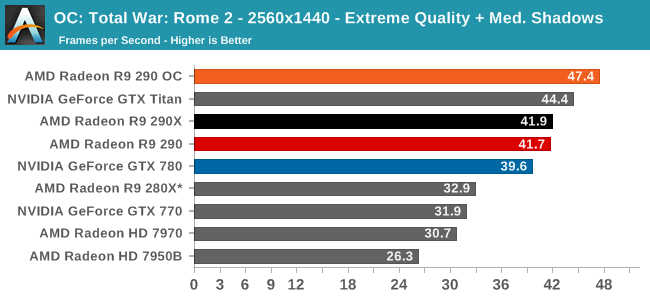
Finally getting to the matter of game performance, we’re seeing consistently strong scaling across every game in our collection. The specific performance increase depends on the game as always, but a 14% core overclock and 12% memory overclock has netted us anywhere between 9% in Metro up to the full 14% in Total War: Rome II. At this performance level the 290 OC exceeds the performance of any other single-GPU card at stock, and comes very close to delivering 60fps in every action game in our benchmark suite.










295 Comments
View All Comments
chizow - Tuesday, November 5, 2013 - link
It's really strange what AMD has done with the 290. Sure it has great price and performance, but AMD has also ramped it up in the key complaint areas, power and noise to get there. As a result, the performance of the 290 is close enough to the 290X that you have to wonder if AMD even wants to sell any 290Xs at all. They are hard enough to find to begin with, but at a $150 price difference for ~5% difference in performance, it seems as if AMD is cannibalizing their own SKUs and dissuading people from purchasing the 290X and choosing the much cheaper 290 instead. It also comes close enough to the 280X while thoroughly stomping it to make the 280X seem much less attractive in that $300-$400 range.In the end the 290 seems like a strong buy for anyone who is willing to tolerate the heat and the noise. It's amazing that the 290 is even hotter and louder than the 290X, even taking the crown from the previous high-end, noisy fireball GTX 480 (thanks for including it in these results this time btw). It's certainly possible AMD wants this SKU to sit by itself in that $400 slot, safely away from the 770/280X below it and the GTX 780/290X above it.
dragonsqrrl - Tuesday, November 5, 2013 - link
The GTX480 is not the previous 'noisy fireball'. AMD has introduced many cards since that make the 480 seem downright reasonable. Take the 6990 and 7970GHz for example. AMD has gone so far and beyond Nvidia in terms of heat and noise it seems comical to still hear people talk about the 480 as though it's some kind of benchmark to compare these cards against. The stock coolers on these recent gen high-end cards from AMD have been much louder.HisDivineOrder - Tuesday, November 5, 2013 - link
Everyone who knows anything knows the FX5800 is the benchmark of loud cards. Seriously, that thing was, is, and will always be the Leaf Blower of Legend.That said, the 290 is a very well executed attempt to catch the myth and make real the loud card of lore we once thought dead and gone.
creed3020 - Tuesday, November 5, 2013 - link
LOL, I too remember the term Leaf Blower being used with the FX5800 for the first time. A friend had it in his rig and we couldn't stop bugging him about it. This was coming from another friend who have three 80 mm Antec Tornados in his case!chizow - Tuesday, November 5, 2013 - link
Agreed that the 480 was probably not as loud, it's fan had issues but didn't have the same high pitched whine characteristic of AMD's blowers. But it was the previously hottest, highest power consuming single-GPU and as an owner of 2 in SLI I can say for sure the heat was a lot to deal with.Mariosti - Tuesday, November 5, 2013 - link
Now think about this:290X with new drivers, and proper cooling enabling it not to just "not throttling" but also to get some minor oc. The difference will be much bigger. That's why nvidia must go all the way with GK110 unlocking to make the 780Ti a viable competitor.
TheJian - Tuesday, November 5, 2013 - link
Or NV can just OC their cards until they hit another 10DB or 50-70watts and laugh right? This is all AMD has done. Why didn't AMD just include this magical fan in the ref design? Overclocks show there isn't much in the tank either. Don't forget they're using NV ref here also. You can buy OC cards that are already clocked 10%+ faster out of the box and reviews show they are quiet in comparison which NOBODY buys.jnad32 - Tuesday, November 5, 2013 - link
The way I look at it, AMD is looking like an absolute genius. Everyone was ripping them on the 290X for it being too hot and too loud anyway. So instead of keeping the sound levels down they just went for what they do best, price/performance. They are now blowing every other card out of the water. There isn't a card on the planet that can touch this card in price/performance. Yea its loud as hell but, at least you have to think about it now just because of the price. What I really want to see is them unleash the 290X sound threshold and see what kind of raw numbers it can put up. Lets be honest, the only people who should buy reference cards are the ones who are putting water blocks on them.Dal Makhani - Tuesday, November 5, 2013 - link
hmm seems like this card in a somewhat "uber mode" fan profile cannibalizes AMD's own R9 290X?HanzNFranzen - Tuesday, November 5, 2013 - link
Ok, fine, the reference cooler sucks. But we all know that sooner rather than later there will be several versions with non-reference coolers available. So instead of get 106% of a 780's performance for $100 lees, we will get it for $70 less. (and possibly some more OC headroom?)Any way you slice it, AMD has done a service for all of us enthusiasts no matter if you're an NVidia or AMD fan... The price/performance has come back down to earth. I will be buying one of these cards, no doubt. But I will be waiting to see what Sapphire or Asus come up with as far as cooling or I may just drop for a 3rd party cooler and a reference board.